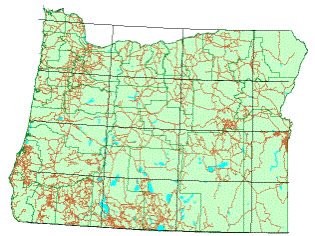

State of Oregon
Universal Transverse Mercator Projection
Central Latitude: 41.75
Central Longitude: -120.5
Projection Characteristics
The Universal Transverse Mercator system, commonly known as UTM, divides the Earth into sixty discrete zones, each representing a vertical slice of the globe spanning six degrees of longitude. A Transverse Mercator projection is applied to each zone with the central meridian of the projection at the center of the given zone and the central latitude of the projection at the equator. This coordinate system is the basis for many standardized regional maps, such as tract or neighborhood maps by the US Census Bureau and topographic quadrangles by the US Geological Survey. UTM is not generally used for coordinates outside the range of -80 to +84 degrees latitude due to the distortion inherent in Transverse Mercator projections near the poles.
Projection Parameters
Parameter |
Description |
Name |
Specifies the units used in the map. |
Scale |
Specifies the unit scale of the projected map, relative to meters. For example, a scale of one means one unit in the projected map equals one meter; a scale of two means two units in the projected map equal one meter; etc. |
Central Scale Factor (KO) |
Specifies the central scaling factor for the projection. This value is often set to 1.0, but may be set to another value for specific applications. |
Central Longitude |
Specifies the central longitude of the projection in degrees. The Central Longitude value typically should be defined as the longitudinal center of the map you are going to produce. For example, the value -95.5 represents the geographic center of the United States, so the map of the U.S. is drawn upright. |
Central Latitude |
Specifies the central latitude of the projection in degrees. The Central Latitude value should be defined as the latitudinal center of the map you are going to produce. |
Projection in Southern Hemisphere |
Choose True if your map is in the southern hemisphere. Choose False if your map is in the northern hemisphere. |
See Also
Introduction to Map Projections
Characteristics of Projections